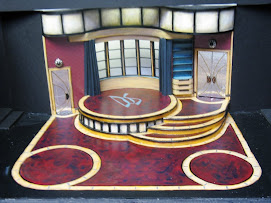So, we want it to be as real as possible without the actors actually hurting each other... Here are a few things I discovered in rehearsal:
The Stage Slap
Have you ever tried to smack someone properly? It's very technical, you see... Rick explained it to us, and I'll pass it on to you.
There are many variations of a stage slap. Most include not hitting the face at all. It's all about the placement of the hands and angling the body correctly. The victim's reaction plays a big part, too. The slap we're using, primarily, is a little different. We do actually connect with the face, but in a way that's a little safer than your average heat-of-the-moment cuff to the chops.
Practice at home with a friend -- fun party trick! The "slapper" must keep a cupped hand and strong wrist. When you connect, avoid the ear and cheekbone. Go for the jawline and lower cheek. Follow through. The "slap-ee" can help by setting their jaw in preparation for the slap. If it's done right, you should hear a nice sharp sound, and "slap-ee's" face should not be stinging (much). (Side note: As Rick explained the maneuver, Ann and I dutifully began slapping our own faces to see what we were missing).
Rooted in Reality
Bottom line (again): the fight's not real. But it can be truthful. Rick was very adamant about this. Our reality is that these characters have been locked in a room together, working on this Godforsaken screenplay, for three solid days. No sleep. No real food. The book calls for Scarlett to slap the young black maid, Prissy, and Hecht won't write it. The first two hits come when Fleming decides to demonstrate the slap in question using Hecht as his Prissy. The slapping lazze begins.
Rick says, "it's not the actual slapping, but the shift in focus that makes it funny." (Ann: [tapping my paper] "Put that in the blog!") Each slap becomes another moment in the conversation -- "did he really just do that?!" "Can I hit him back?" It becomes a game of who-slaps-who, one-upmanship and pride -- all under the guise of work. It's also about timing and rhythm. In a sense, it's not really a fight, just an intense late-night writing session.
Choreography
After the slapping lazze comes the "free-for-all" that Hutchinson requests. Although a fight scene is a bit of dance, it's not choreographed like one. There aren't any set steps. Each moment is built, one by one, from the last thing that happened.
It begins with a bit of a chase, a la Bugs Bunny. Selznick gets slapped and doesn't like it (think: someone accidentally hit Dad and now he's angry)... Hecht bolts, jumps over the couch... Selznick spies Fleming, circles the desk... the room becomes a battlefield. Anything and everything is fair game for ammo. Bananas, peanuts, garbage bins, books, wigheads.... yes, wigheads. (A suggestion from our lovely ASM Leslie). Rick starts talking about using the physics of the room. When does the tension build? When is it released?
The best surprise of the day happened when the fight magically resolved itself. I won't reveal much... just think wigheads, a floor fan, and a whole bunch of symbolism.
-- Andrea

No comments:
Post a Comment